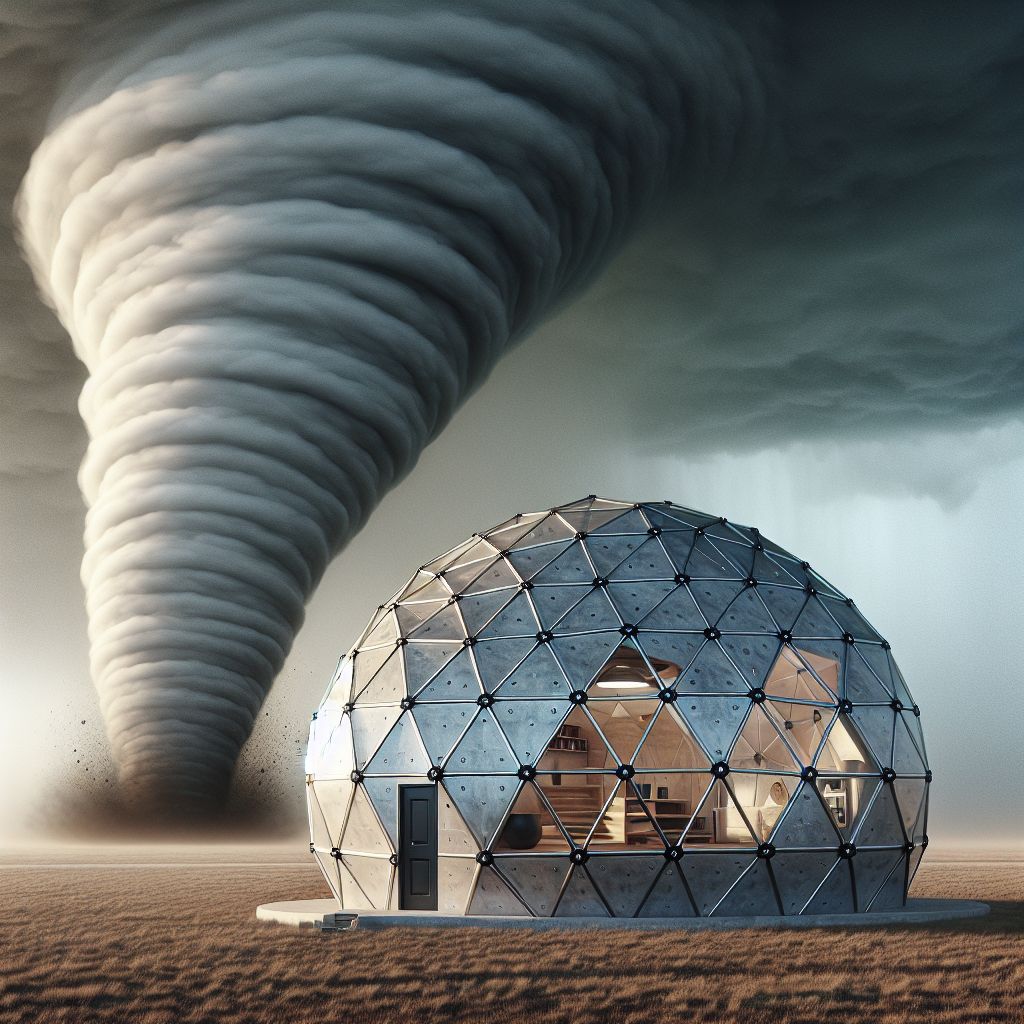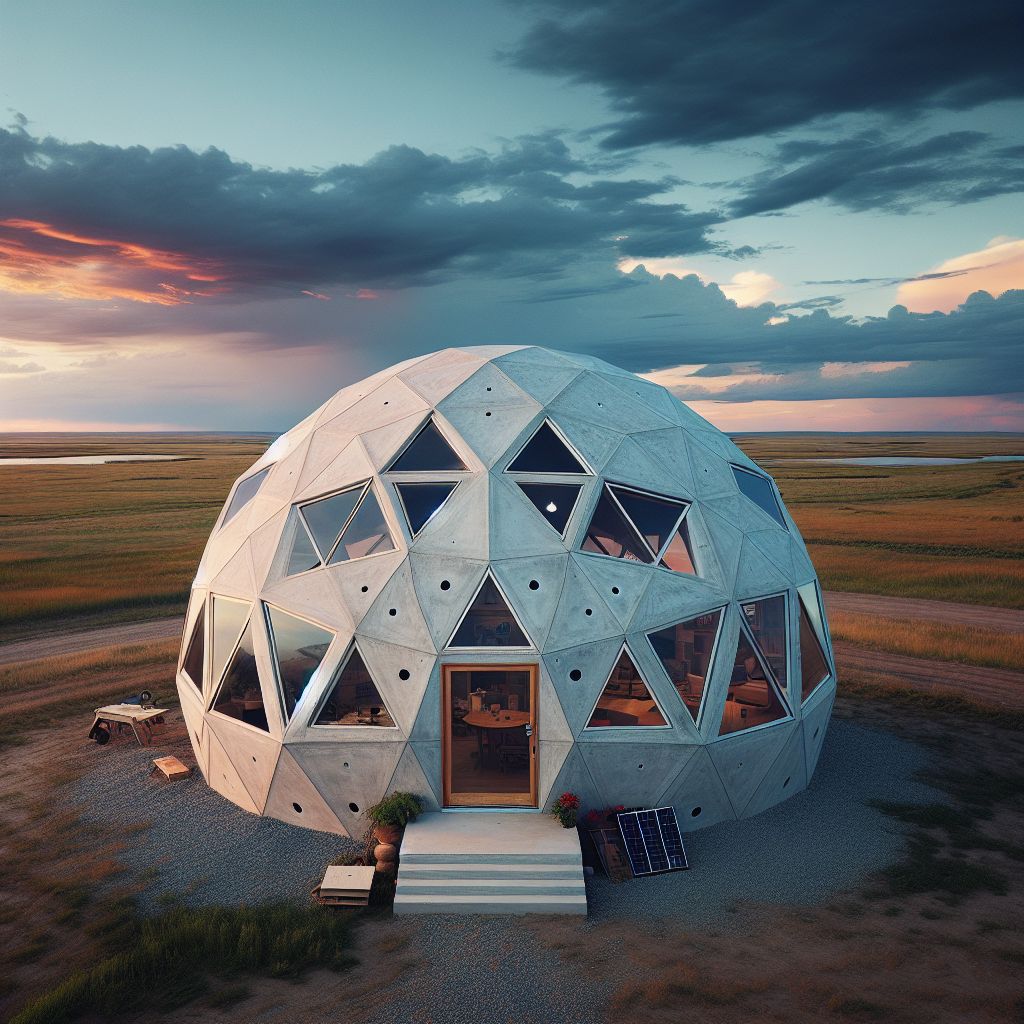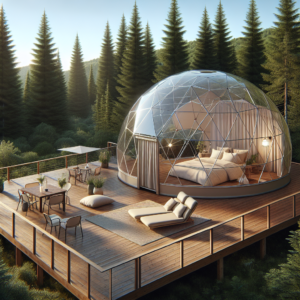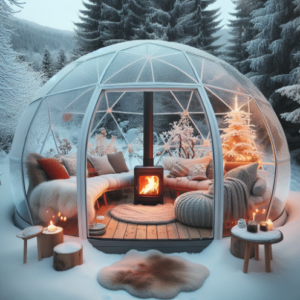
Key Takeaways
-
Geodesic dome homes offer superior resistance to tornadoes due to their aerodynamic shape and structural integrity.
-
Traditional rectangular homes are more vulnerable to high winds because of their flat surfaces and right angles.
-
Using materials such as steel and concrete can significantly enhance the tornado-proof qualities of dome homes.
-
Design features like rounded shapes and secure anchoring are critical in tornado-prone areas.
-
These homes are not only sturdy but also energy-efficient and customizable, making them a practical choice for modern living.
Geodesic Dome Homes: A Synonym for Resilience
When it comes to building a home that can stand up to Mother Nature’s fury, geodesic dome homes are in a league of their own. These homes, with their unique spherical design, have proven to be nearly invincible against some of the most powerful tornadoes. Here’s why: they’re not just homes; they’re your personal shield against the sky’s mightiest winds.
Why Traditional Homes Fall Short
Let’s talk about the typical house for a second. You know, the one with four walls and a pointy roof. These are great until a tornado comes roaring like a freight train. The flat walls and sharp corners of traditional homes are like a catcher’s mitt for the wind, giving it something to grab onto and tear apart. That’s why, in tornado alley, you’ll see houses ripped open like cardboard boxes.
The Geodesic Advantage: Strength and Aerodynamics
Now, picture a geodesic dome home. Its round shape is like a smooth stone by a riverbank – the wind just slips right over it. This design doesn’t just look cool; it’s a scientific marvel. Because of their dome shape, these homes can reduce wind pressure by an astonishing 50%. That means when a tornado hits, a dome home stands strong, while traditional homes might crumble.
Engineering the Ultimate Survival Home

“Surviving Hurricanes and Tornadoes …” from www.monolithic.org
To understand the might of a geodesic dome home, let’s dive into the nitty-gritty of what makes these structures so tough. It’s like a puzzle where every piece supports the others, creating a web of strength that’s hard to break. The secret is in the triangles – loads of them – all coming together to form a dome that’s not just sturdy, but also downright stubborn when it comes to facing down a twister.
Breakdown: Geodesic Dome Structural Integrity
Each triangle in a geodesic dome is a mini fortress. When you combine hundreds of them, you get a structure that distributes stress evenly throughout the entire shape. It’s like a team where everyone carries an equal load, so no one gets overwhelmed. And when the winds howl, this teamwork pays off big time.
Materials That Make a Difference
The materials you choose for your dome home are like picking the best players for your team. Steel and concrete? They’re the heavy hitters, providing the strength needed to take on tornado-force winds. These materials don’t just sit there; they actively work to keep you safe, anchoring your home to the ground and making sure it doesn’t budge, even when the wind is screaming like a banshee.
Maximizing Safety: Design Strategies for Tornado-Prone Areas
Building in a tornado hotspot? You’ll want to pull out all the stops to make sure your home can take a punch. And I’m not just talking about a little wind – I mean the kind of storm that sends cars flying. Here’s how you make your dome home as tough as nails.
Reinforcing Against Extreme Winds
First off, you’ve got to anchor your home like it’s a battleship. This means deep, sturdy foundations that go down, down, down into the ground. Then, you want to round off everything. No sharp edges for the wind to catch on. And don’t forget to secure those doors and windows – they should be as tight as a drum.
Smart Design Choices for Debris Impact Resistance
Besides that, when a tornado throws debris like missiles, your dome home’s design is your best defense. Picture this: the spherical shape makes debris more likely to glance off rather than crash through. It’s the difference between a rock hitting a wall and a rock skipping off a pond. By deflecting debris, the dome keeps you and your loved ones safe inside, away from the chaos.
Living in a Dome: Benefits Beyond Survival

Surviving a tornado is the number one priority, but living in a geodesic dome home isn’t just about making it through the storm. These homes come with a slew of other benefits that make them a smart choice any day of the year.
For starters, the interior of a dome home is a marvel of space and light. The open floor plan and high ceilings create a feeling of spaciousness that’s hard to match in a conventional home. And because of their shape, domes naturally encourage air circulation, which keeps the home comfortable and fresh.
But the benefits don’t stop there. Dome homes are often quicker to build than traditional homes, and their components can be prefabricated, which means less waste and a smaller carbon footprint. Plus, their unique look is sure to turn heads and start conversations, making your home not just a place to live, but a statement.
Energy Efficiency and Cost-Effectiveness
When it comes to saving money and the planet, dome homes are a double win. Their design means less surface area exposed to the elements, which translates to lower heating and cooling costs. In fact, dome homeowners often report savings of up to 30% on their energy bills. And because they’re so sturdy, maintenance and repair costs over time can be significantly lower, too.
The Aesthetics of Geodesic Dome Living
The beauty of a geodesic dome home is more than skin deep, but let’s not ignore that skin. These homes have a unique, futuristic look that’s as stylish as it is functional. With the right finishes and touches, a dome home can be as cozy and inviting as any traditional home, with the added bonus of being a conversation starter and a standout in any neighborhood.
Inside, the design allows for creative use of space. High ceilings are perfect for lofted areas, and the lack of load-bearing walls means you can really open up the living areas. Large, triangular windows not only flood the space with natural light but also offer stunning views of the surrounding landscape.
Standing the Test of Time and Nature
One of the most remarkable things about dome homes is their longevity. These aren’t just houses; they’re legacy buildings that can stand for centuries, not just decades. They’re built to withstand not only tornadoes but also earthquakes, heavy snow, and even the passage of time. It’s the kind of home you can pass down through generations, knowing it will shelter your family for years to come.
Real Stories: Dome Homes Weathering the Storm
There are countless stories of dome homes standing tall amidst the rubble of traditional houses. After a tornado, dome owners often emerge to find their home intact, sometimes with nothing more than a few scratches. These aren’t just tales; they’re proof that when it comes to surviving a tornado, a geodesic dome home is your best bet.
Looking Ahead: The Future of Tornado-Proof Housing
The future of housing in tornado-prone areas is looking rounder by the day. As more people witness the resilience of dome homes, the more popular they become. And with advancements in materials and design, they’re only getting stronger and more efficient. It’s not just a trend; it’s a movement towards smarter, safer living. So, when the next tornado warning sounds, those living in dome homes can breathe a little easier, knowing their home is built to last.
FAQs About Tornado-Proof Geodesic Dome Homes
Let’s tackle some common questions about these structures to clear up any uncertainties you might have about making a dome home your own personal fortress.
How do geodesic dome homes provide tornado resistance?
The dome’s curved surface allows wind to flow around rather than against the structure, significantly reducing pressure and the risk of structural failure. Moreover, the interconnected triangles create a self-supporting framework that distributes any force applied across the entire structure, ensuring it remains standing even under the most extreme conditions.
This geometric design, paired with sturdy materials like steel and concrete, means that a geodesic dome can withstand winds far beyond what a conventional home can handle. It’s like comparing the stability of an eggshell to a stack of cards in the face of a powerful gust.
What are the initial cost comparisons to traditional homes?
Building a geodesic dome home can be surprisingly cost-effective. While the initial investment might be similar to or slightly higher than that of a traditional home—ranging from $130 to $200 per square foot—the long-term savings in energy efficiency and reduced maintenance can more than make up for it. In essence, you’re investing in a home that not only protects you from tornadoes but also keeps your wallet from being blown away by ongoing expenses.
Additionally, the construction process for dome homes often involves fewer materials and less labor, which can lead to savings during the building phase. It’s important to note that costs can vary widely depending on the size, location, and customization of the home.
What customization options are available for dome homes?
The options are as vast as your imagination. From the exterior finish to the interior layout, dome homes can be tailored to your personal taste and needs. You can opt for an ultra-modern look with sleek materials and large glass windows, or go for a more traditional appearance with wood or stone finishes. Inside, the absence of load-bearing walls means you have the freedom to design open, airy spaces that suit your lifestyle.
Where can I find builders who specialize in geodesic dome construction?
Finding the right builder for your dome home is crucial. Start by researching companies that specialize in geodesic dome construction. Many of these firms offer pre-designed kits that can be customized to your preferences. You can also reach out to the growing community of dome homeowners for recommendations. Online forums and social media groups dedicated to dome home living are great places to connect with experienced builders and get first-hand advice.




